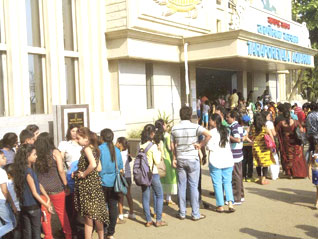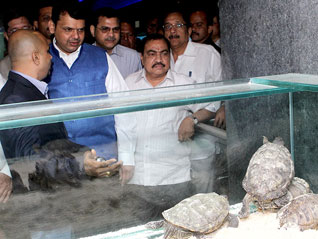Current Events
Desperate For Timepass
But Nowhere To Go
SAMAR HALARNKAR
It is 6:15 pm on a humid, suffocating May evening in Mumbai. The sea breeze has died, and the people in the half-km queue are flushed with heat and drenched in sweat.
Yet, they wait, with fidgety children, on the seaside promenade of Marine Drive. The closing time is 45 minutes away, and it is clear many will not get in; those who do will have to leave almost immediately.
Yet, they wait to get into the 64-year-old Taraporevala Aquarium, which reopened this year after a Rs 22-crore revamp. That’s roughly $ 3.5 million in US Dollars.
Weeks after it revealed its shiny, new avatar, about 100 fish, many imported, died. The aquarium found it a challenge filtering the seawater -- some of world’s most polluted -- it was drawing from the bay across the road.
Yet, the Indians wait in the queue, for they have heard of its touch-tank, where children can stroke starfish, and an acrylic-glass tunnel that lets selfie-happy crowds take photos against the fish that swim overhead and all around.
Taraporevala is India’s largest such institution, but by global standards, the aquarium is basic -- it would probably fit in the lobby of its cousins in Boston and Sydney, with space to spare. It has no sharks, and if you use a camera, you must pay Rs 1,000 - US $20. The ticket to get in is Rs 60.
Across the road, two teenage girls gaze at the queue. “Chance nahin hai andar jaane ka,” says one. “Chull scooter dekhte hain.” Since entry is impossible, they turn to the lone water-scooter bouncing along Chowpatty bay. The girls join a crowd licking iced lollies and gazing at the scooter, driven not by the paying customer but by a man seated behind her.
Only in India.
Further down the promenade, there is another congregation of the idly curious -- watching a bobbing jetty. Marine Drive itself is packed. As I run, I bob and dodge crowds on a promenade that is at least 25-foot-wide. On the road, helmetless motorcycle riders whoop and scream as they weave in and out of traffic at high speed.
The hopeless queue, the idle crowds, the motorcycle death-defiers -- they are involved in a time-honoured Indian pastime. They have nowhere else to go this muggy Sunday, so they congregate where space and opportunity, however meagre, allow them ‘timepass’, as the Indianism goes.
It is much the same in India’s teeming cities. With prosperity -- per capita income has risen more than 450% over the last 20 years -- has come spare time, and even the poor look for relief from daily drudgery. Those who can spare the time and money holiday hard, but millions who cannot are left behind each summer in explosively growing cities.
About 43% of the urban population lives in 53 cities with more than a million people. In 2001, there were 35 such cities; in 1951, the year the Taraporevala aquarium opened its doors, there were just five, including Mumbai. Nearly 65 years later, in which time the city’s population has risen seven-fold, from 3 million to 21 million, the aquarium remains one of Mumbai’s biggest attractions, an example of the city’s failure to provide leisure spaces to its people.
The other major nature-based attraction, the Jijamata Udyan, the zoo, has barely changed since it began life in 1861 as the Victoria Gardens. A grand revamp -- including an incredible idea to house penguins -- has trundled along.
About the city’s scraggly parks and promenades, there isn’t much to say -- except that little patches of green (the mangroves plastic-festooned) are guarded by neighbourhood associations, with rights of access fiercely contested by the rich and poor, senior citizens and children, developers, politicians and locals, humans and dogs.
Mumbai is a microcosm of increasingly congested, hard-working and desperate-for-timepass urban India.
In Bangalore, once India’s garden city, a 70% drop in foliage has led to the evisceration of its once grand lakes and pristine parks and avenues. The few neighbourhood parks are made available to the public only between 6 am and 10 am and 4 pm and 7 pm daily, weekends included. The rationale: Canoodling couples and “criminal elements”, in the words of an administrator, might “misuse” the parks if they stay open in the day.
Delhi has India’s best and biggest parks (and they stay open through the day), but if you live in the wrong part of town -- which is everywhere, except the leafy south -- your timepass options are limited to dangerous cruising, mall-trawling and cat-calling.
Other cities may have a couple of showpieces -- Hyderbad’s Hussain Sagar Lake and its rickety amusement park; Madras’ Marina Beach, Poona’s, well, no place I can think of -- but public leisure spaces are at a premium.
The most impressive were created before Independence, almost none this century.
This may change.
Narendra Modi’s legacy in Gujarat is hotly debated, but in creating the popular Rs 1,200-crore Sabarmati waterfront, which he proudly showed off to Chinese President Xi Jinping last year, he tapped directly into the middle-class desire for open spaces. Cities experimenting with closed streets on weekends (Bangalore, Mumbai) are catering to these desires, and the blueprint for Andhra Pradesh’s new capital, Amravathi, reveals a 35-km riverfront and acres of open space.
Currently, most new leisure areas in and around Indian cities are private, shut to the vast majority of Indians. Like so much else, leisure spaces, too, have become modes of secession from the republic. As a consequence, India has very low expectations of public spaces.
A few months ago, when my mother-in-law and my daughter went to the Mumbai zoo (who does that, right?), they found much desolation and few animals.
Where are the tigers, lions and giraffes? asked my mother-in-law of two zoo workers.
“Teen saal lagega,” was the vague reply. Come back in three years.
Amused that someone would make a serious zoo visit, he turned to his colleague and said: “NRI hoyega.” Must be an NRI, a visiting non-resident Indian from abroad.
Samar Halarnkar is editor, Indiaspend.org, a data-driven, public-interest journalism non-profit.
[Courtesy: Hindustan Times. Edited for sikhchic.com]
May 30, 2015
Conversation about this article
1: Kaala Singh (Punjab), May 31, 2015, 3:16 AM.
This is the quality of life offered by "Incredible India". It is really amazing to see them going around the world touting this pit as the next big thing!
2: Parvinder Singh (Chandigarh, Punjab), May 31, 2015, 7:18 AM.
I was born and raised in Chandigarh ... and I feel so lucky about it.




